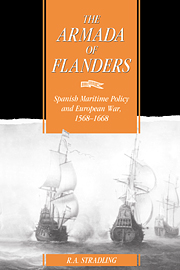Book contents
- Frontmatter
- Contents
- Preface
- Acknowledgements
- Glossary
- Rough comparative values of Spanish and Flanders currencies, c. 1620–60
- List of abbreviations
- Maps
- Part I Prologue – Failure and retrenchment, 1568–1621
- Part II The great offensive, 1621–1640
- Part III Dunkirk and the defence of Empire, 1640–1658
- 6 The Flanders fleet in the South
- 7 The prize of Dunkirk
- Part 4 Quills, keels and cutlasses
- Epilogue Decay and transition, 1658–1668
- Appendices
- Bibliography
- Index
- Cambridge Studies in Early Modern History
6 - The Flanders fleet in the South
Published online by Cambridge University Press: 22 September 2009
- Frontmatter
- Contents
- Preface
- Acknowledgements
- Glossary
- Rough comparative values of Spanish and Flanders currencies, c. 1620–60
- List of abbreviations
- Maps
- Part I Prologue – Failure and retrenchment, 1568–1621
- Part II The great offensive, 1621–1640
- Part III Dunkirk and the defence of Empire, 1640–1658
- 6 The Flanders fleet in the South
- 7 The prize of Dunkirk
- Part 4 Quills, keels and cutlasses
- Epilogue Decay and transition, 1658–1668
- Appendices
- Bibliography
- Index
- Cambridge Studies in Early Modern History
Summary
CRISIS OF IDENTITY
Joseph Bergaigne, exiled bishop of the town of's Hertogenbosch, having been at court on royal service, was returning to Flanders in the last weeks of 1640. After an uncomfortable journey across northern Spain from Burgos to La Coruña, he was further frustrated on arrival, to find the vessel waiting for his conveyance. The good priest's patience was not what might be expected from a humble pilgrim travelling on the hard road to Galicia.
Naturally, I console myself with resignation to the will of God, considering also the duty which I owe my King. But the transport here, which was supposed to be a Dunkirk frigate, turns out instead as only the packet-boat which has brought the mail from Flanders, a tiny craft manned by only seven or eight crew, with no guns, and hardly the kind of thing to which a person of condition should be obliged to entrust his safety.
Considerate though he normally was over the sacrifices made in his service, it seems doubtful that Philip IV had time to be greatly exercised by the bishop's plight. The Catalan rebellion was making dramatic inroads into his authority, and the shattering news of the Lisbon uprising had only just reached Madrid. The shortage of men was such that only the importance of communications with Flanders, and no consideration for the feelings of persons of condition, prevented the packet-boatmen from being pressed into the navy proper.
- Type
- Chapter
- Information
- The Armada of FlandersSpanish Maritime Policy and European War, 1568–1668, pp. 113 - 130Publisher: Cambridge University PressPrint publication year: 1992



